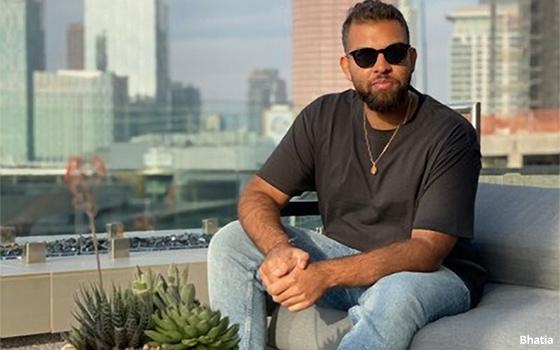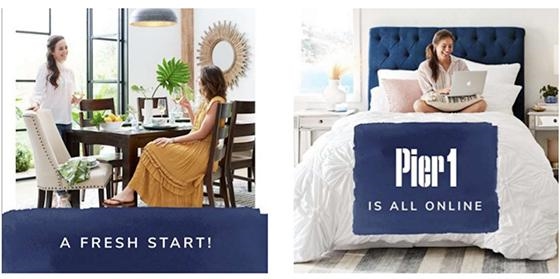Pier 1 Trades Bricks for Clicks As D2C Pure Play

Pier 1 was not just another decades-old bricks-and-mortar brand having to “figure out digital.” Serendipitous discovery inside the attic-like physical ambience of those capacious stores was core to the Pier 1 experience. Could its new owners translate that into Web pages and buy buttons?
The answer is yes, when you have no choice, and when you’ve done it before. Pier 1 closed all of its stores by third quarter this year, and Retail Ecommerce Ventures (REV) bought the IP and data in July.
REV has been collecting zombie retailers like Modell’s, Dress Barn and, just recently, Radio Shack, with the aim of relaunching them as D2C ventures. AJ Bhatia had been CMO of Dress Barn and is now CMO of the Pier 1 brand. As he told us at this month’s Search and Performance Insider Summit, his solution to the Pier 1 challenge was to retarget online the brand’s traditional customers and to translate the unique in-store experience by putting content and attention to detail at the center of the new Pier 1 experience. You can listen to the entire podcast here.
MediaPost: When a chain like Pier 1 closes its 500 stores, you lose an enormous branding presence. So how do you translate that into a digital brand awareness and retention program?
Bhatia: When we acquired it, it was a very interesting time, because most of the country was still on lockdown or had some sort of lockdown going. The whole transition happened extremely fast. It wasn’t a long, drawn-out wind-down process where there’s this crazy going out of business sale and the stores were turned into liquidation outlets. So we got ahead and… really owned the messaging across all social and display.
MediaPost: Bring us into that. What was the media strategy here? You have to replace an old brick-and-mortar set of techniques and media channels for raising awareness with digital.
Bhatia: The first few days we launched the site, we started really small on budgets. We turned on this basic brand search, some basic Google Shopping. And then we turn on some social ads. Then we got affiliate going to test the waters during our soft launch the first few days. We were running into people calling us out or saying that hey, the brand’s closed. These are liquidated products or whatever. So there was a lot of confusion in that sense. And then there were people really confused. “Hey guys, I thought, Pier 1 went out of business.”
So we put our heads together to get ahead of this. What can we do to get the messaging out there that we’ve relaunched as a pure play ecommerce brand?
One thing we did was put a lot of money behind awareness posts on social, specifically Facebook and Instagram. We did an announcement post. And then we did that on display, where we basically saturated all the list we had on display. And the biggest list was anyone that has ever purchased on the Pier 1 legacy site. We had some in-store data, and we saturated that list as well.

MediaPost: We have some creative, so let’s look at the messaging here.
Bhatia: Yeah, it’s really simple, because we didn’t want it to be confusing. The goal here wasn’t to sell product. It was just to get the messaging out that we’re back and we’re online, and we wanted to have that top-of-mind messaging.
So in the future when the customer is ready to get reed diffusers or whatever it is, we have that top-of-mind awareness. So our goal was really to go as simple as possible and go as wide as we can with this messaging. And I think it worked, because after we did this, actually we saw a lift in brand search as well. And we saw a pretty solid increase in traffic. Pretty simple.
MediaPost: Let’s go to the next example. [See image above]
Bhatia: I think it’s the most important piece of content that we put out. So we put this out on social, but we also leveraged Facebook awareness campaigns for this one. We put a lot of budget on this one, targeting a lot of our custom audiences, store buyers, store visitors, Pier 1 interest, and anyone that’s really engaged with Pier 1 ads on Facebook and Instagram, to get ahead of the messaging. And this one I think is one of our most engaged posts on organic social. It’s definitely our most engaged post on paid social.
MediaPost: You were really focused in the beginning on converting that Pier 1 list of existing customers. But what was the customer acquisition strategy?
Bhatia: Pier 1 has a lot of very specific products that are tried and true to Pier 1. So we really pushed those products as our key drivers on search, on paid search specifically. Like the Papasan Chairs is a high search volume known to Pier 1. We have reed diffusers that are very specific to Pier 1, a lot of room sprays and fragrances that are very specific to Pier 1, and we use those as drivers. Those specific products perform best for us on shopping.
MediaPost: But now you’re also in a field where you’re competing with pure plays like Wayfair and Overstock in the home category. So how are you differentiating within this space now?
Bhatia: It’s challenging, because I’ve noticed is a lot of the products in the space are very similar. I just recently moved to Scottsdale, so I’ve been doing a lot of furniture and home shopping myself. I’ve gotten to analyze my own shopping habits in the process. I’ve been searching on Pier 1, Wayfarer, Overstock, Amazon and all of them. And the funny thing is, all sites have pretty much the same assortment of product, because there’s key vendors in the space that really service everybody.
So it comes down to one thing that we’ve been really heavy on. What can we do on a content strategy side to really set ourselves apart? Because if everyone is selling the same products or similar products in design, it comes down to, how are you able to merchandise these on the site? How are you able to give inspiration in the process?
So we recently relaunched the blog. We’ve been really focusing heavily on proper photography, even for non-owned inventory and our drop-shipped inventory specifically. Where most companies aren’t investing in creative for their non-owned inventory, we’re actually going really heavy into that.
MediaPost: That idea that you can use content and take some of that brick-and-mortar experience of going into a Pier 1, a certain ambiance, certain serendipity, and translate that into digital terms — that’s what a lot of the content is about.
But that also extends into some of the relationships that you’re exploring. You really bulked up on affiliates, right? We were going to a season where everybody was heavying up on affiliates because they were really overperforming. What did you do to squeeze more performance out of that channel?
Bhatia: We got really aggressive on our commission rates for the relaunch. We had access to who were the top drivers on affiliates in the past. So I got on the phone with our affiliate team and we put a bunch of bonus targets in place for them. And then we upped their commission percentage a little bit to incentivize them as well.
MediaPost: We’ve mentioned social influencers. You have an interesting take on how you’re using social influencers. What is your 2021 plan?
Bhatia: There’s really two ways to go about it. There’s kind of like that peanut butter spread method, where you go super wide and get as many influences you can to promote the brand. It’s kind of like the Fashion Nova approach, where they try to saturate Instagram.
The other method is a little more curated. [You] pick a handful of influencers that are relevant to the brand and the brand story. They can do an extended piece of content and be more brand ambassadors rather than just influencers.
We’re going to roll out an influencer program that goes for the more curated story-telling influencers and already have an aesthetic that’s similar to Pier 1. We’re going to be doing commercials around them, as well as do website features and then curated collections on the website to go deeper into the storytelling, rather than finding 1000 influencers and slapping a coupon code on their page.
MediaPost: Why do you think that beats breadth?
Bhatia: I think in this age people value authenticity and storytelling. And I think at this point in time, people can tell if it’s just a one-off paid-for post. I think to this demographic, it has a sense of being disingenuous that they’re kind of buying a shout-out, versus this is a strategic partnership. The brand supporting the influencers, and influencers supporting the brand, I think goes a lot further.
(36)
Report Post





